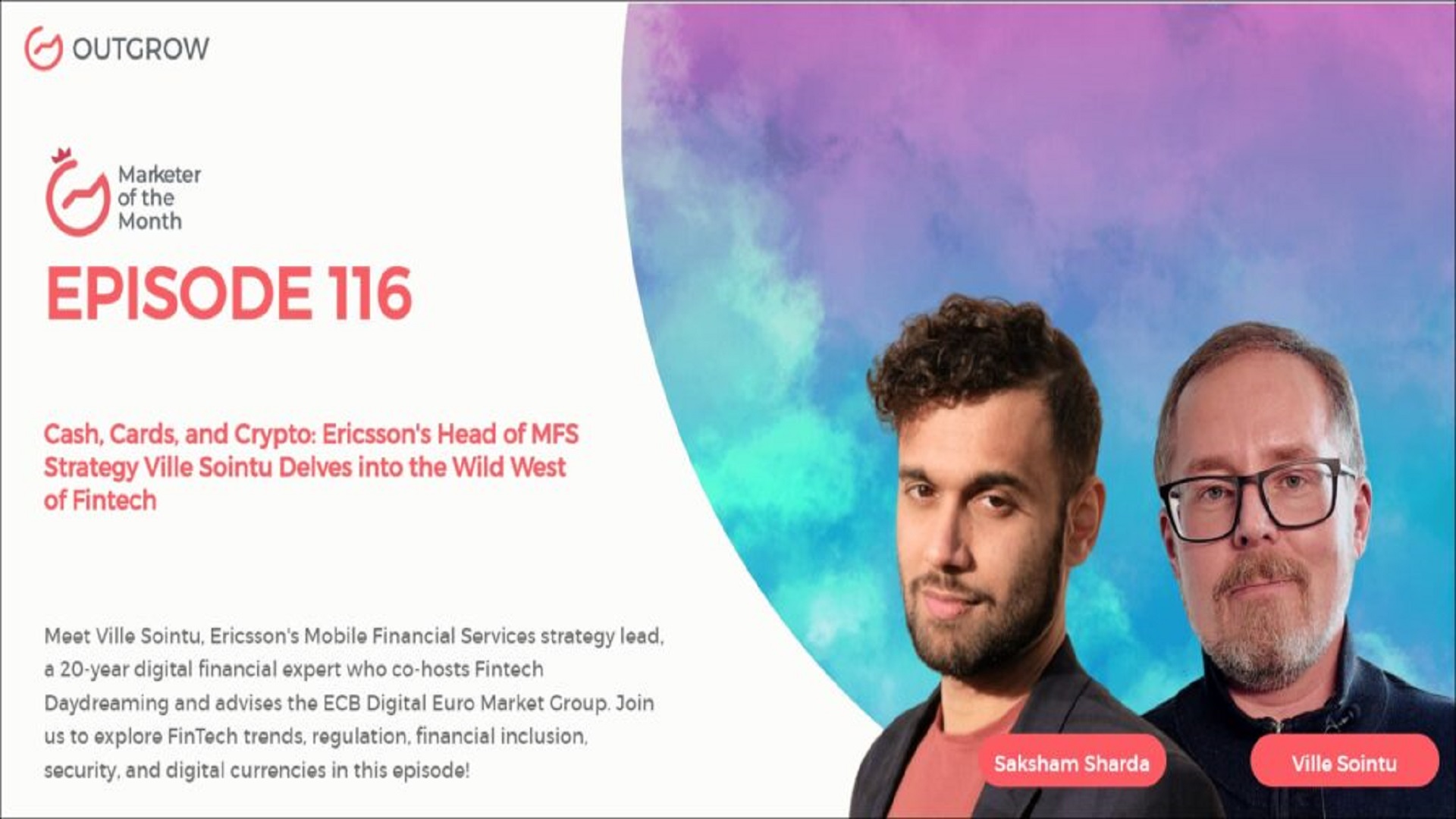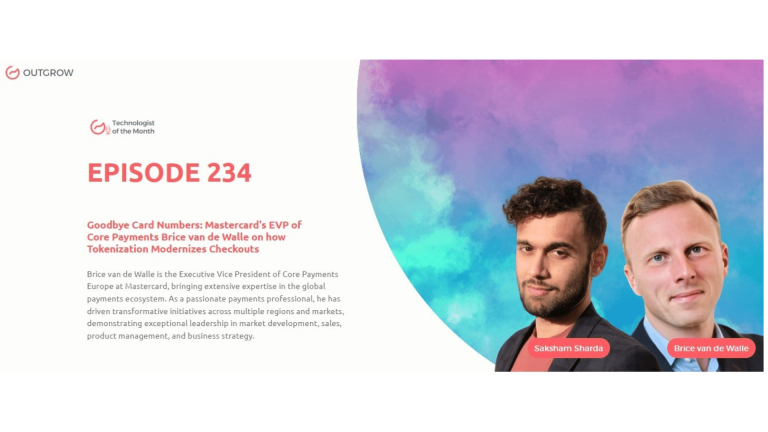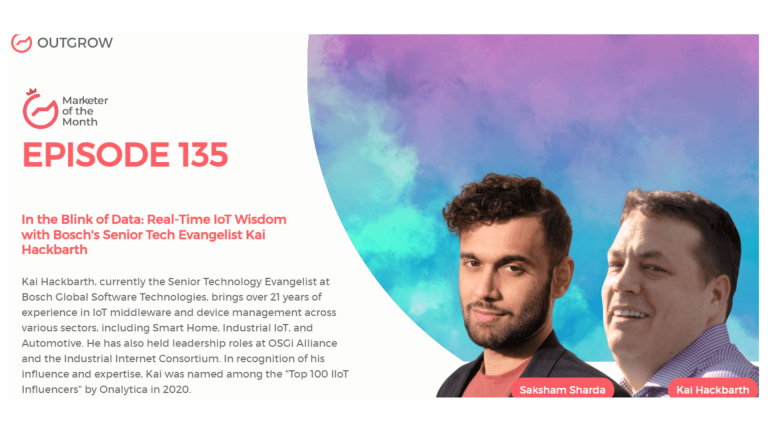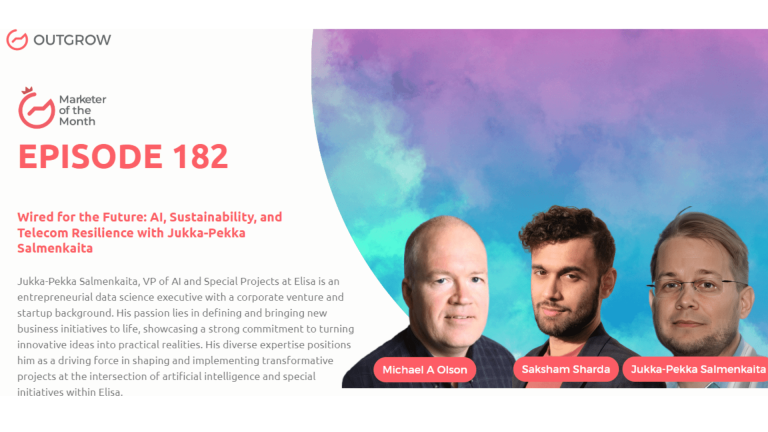EPISODE 116: Marketer of the Month Podcast with Ville Sointu
Table of Contents
Hey there! Welcome to the Marketer Of The Month blog!
We recently interviewed Ville Sointu for our monthly podcast – ‘Marketer of the Month’! We had some amazing insightful conversations with Ville and here’s what we discussed about –
1. Key trends in financial technology and payments
2. Evolution of regulations and the collaborative infrastructure for seamless payments and digital identity
3. Technology’s role in driving financial inclusion
4. Balancing innovation and security in FinTech
5. Potential impact of central bank digital currencies
6. Promising use cases for mobile money in emerging markets
About our host:
Dr. Saksham Sharda is the Chief Information Officer at Outgrow.co. He specializes in data collection, analysis, filtering, and transfer by means of widgets and applets. Interactive, cultural, and trending widgets designed by him have been featured on TrendHunter, Alibaba, ProductHunt, New York Marketing Association, FactoryBerlin, Digimarcon Silicon Valley, and at The European Affiliate Summit.
About our guest:
Ville Sointu, Ericsson’s Mobile Financial Services strategy lead, is a 20-year digital financial expert who co-hosts Fintech Daydreaming and advises the ECB Digital Euro Market Group. Join us to explore FinTech trends, regulation, financial inclusion, security, and digital currencies in this episode.
Cash, Cards, and Crypto: Ericsson’s Head of MFS Strategy Ville Sointu Delves into the Wild West of Fintech
The Intro!
Saksham Sharda: Hi, everyone. Welcome to another episode of Outgrow’s Marketer of the Month. I’m your host, Dr. Saksham Sharda, and I’m the creative director at Outgrow. co. And for this month we are going to interview Ville Sointu, who is the Mobile Financial Services strategy lead at Ericsson. Thanks for joining us, Ville.
Ville Sointu: Great to be here. Thank you.
Don’t have time to read? No problem, just watch the Podcast!
Or you can just listen to it on Spotify!
The Rapid Fire Round!
Saksham Sharda: So let’s start with the rapid-fire round. The first one is, at what age do you want to retire?
Ville Sointu: It’s an interesting question that I haven’t thought about. So I mean, there’s always the official age, when you want to retire, which could be later, which could be also earlier.
Saksham Sharda: Maybe, it is a rapid-fire so you’ve to answer in one word.
Ville Sointu: Okay. I want to retire at 65.
Saksham Sharda: What’s your favorite mobile app?
Ville Sointu: Walt food delivery.
Saksham Sharda: How long does it take you to get ready in the mornings?
Ville Sointu: 50 minutes.
Saksham Sharda: The most embarrassing moment of your life.
Ville Sointu: In one word?
Saksham Sharda: Or a sentence.
Ville Sointu: Yeah. When I had to go skiing during my military service.
Saksham Sharda: Okay. Mountains or Beaches?
Ville Sointu: Beaches.
Saksham Sharda: What’s the most useful mobile feature you can’t live without?
Ville Sointu: Location.
Saksham Sharda: Favorite color?
Ville Sointu: Black.
Saksham Sharda: What time of day are you most inspired?
Ville Sointu: Morning.
Saksham Sharda: How many hours of sleep can you survive on?
Ville Sointu: Eight.
Saksham Sharda: Fill in the blank. An upcoming technology trend is ______
Ville Sointu: Artificial intelligence as a technology trend is overhyped.
Saksham Sharda: The city in which the best kiss of your life happened?
Ville Sointu: Prague.
Saksham Sharda: Android or Apple?
Ville Sointu: Apple.
Saksham Sharda: The biggest mistake of your career?
Ville Sointu: I’ll pass.
Saksham Sharda: How do you relax?
Ville Sointu: I play my PlayStation.
Saksham Sharda: What do you play on the PlayStation?
Ville Sointu: God of war at the moment.
Saksham Sharda: How many cups of coffee do you drink per day?
Ville Sointu: 12.
Saksham Sharda: A habit of yours that you hate.
Ville Sointu: Drinking too much coffee.
Saksham Sharda: The most valuable skill you’ve learned in life?
Ville Sointu: Speaking English.
Saksham Sharda: City or countryside?
Ville Sointu: City.
Saksham Sharda: The last one is your favorite Netflix show.
Ville Sointu: At the moment, it’s gotta be the Last of Us on HBO.
The Big Questions!
Saksham Sharda: Okay. All right. So that was the end of the Rapid Fire round. Yeah. Now we are gonna go on to the bigger questions.
Ville Sointu: Okay.
Saksham Sharda: So, as a veteran in financial technology and payments, what are some key trends you are seeing in the industry currently?
Ville Sointu: Currently, it’s a lot about the evolution of the regulation that defines financial services. So we’re seeing companies that are not banks entering this space. And this is creating a new conversation around what we call embedded financial services. In this embedded financial services. Any user experience, any application can have payments, even financing, and other financial services as part of that user experience. So it’s, you don’t jump to do your banking. It’s the financial service that just becomes a natural part of everything. And because of this new distribution mechanism, of financial services, there’s a lot of conversation around what is the role of a bank. How do you regulate, how do you control? And how do you create security around these embedded experiences for users so that everything becomes easy, but at the same time, safe? That is not the number one trend that I’m looking at at the moment. The second big trend that we’re working on actively is central Bank digital currencies. So the central banks traditionally have only given physical cash out for regular citizens like you and me to use. And other than that everything is delved through the banks with the central bank digital currency conversation going on right now. The central banks want to understand if it is possible to create a digital equivalent of physical cash in an online world. The central banks want to protect the public option for any payment mechanism. Now that physical cash is diminishing, its usability is. So in an online environment, there is a good question to be asked. What is the role of a central bank in this online environment where physical cash cannot be used? So that’s the second big trend that of course, we are quite keen on following at the moment. The third one is collaborative infrastructure. Sounds a little bit nerdy and boring, I know, but, in practice means things like digital identity payment interoperability, the ability to send payments from one account to another account without ever thinking about where the other account is. For example, in the world of mobile phones and mobile technology, this is already true. I mean, I can dial a number, I can send a WhatsApp message to a number without ever thinking if the other side is on my same network, for example, or not. We want to achieve this same goal in financial services as well. And I think this common infrastructure is making this happen. Interoperability is a key topic that we need to address in the financial sector in general.
Saksham Sharda: And so what is the trend that is overhyped, but you don’t think it’s a trend?
Ville Sointu: So artificial intelligence in general has been overhyped throughout its existence. So, if you look at the history of artificial intelligence in the artificial intelligence conversation, started to like the case, the first hype cycle was around the eighties when their first computers came around. And the artificial intelligence, of course, failed to material beyond simple chatbots. Effectively now we’re seeing another wave of hype around artificial intelligence. And, I think that while some of the applications are very impressive, including the well-known chatGPT, which everybody keeps on talking about, I think there’s, as always the overhyping of, its capabilities quite clear already at this stage. At the same time having gone through a lot of these hype cycles before. So there was a hype cycle around blockchain technologies, for example, cryptocurrencies, all these things, none of them have acted, have delivered on their huge promises of upending the world. And we’ve seen this go away. But as with blockchain, as with mobile applications and mobile payments, and as we’re seeing right now with artificial intelligence and more specifically generative AI there’s gonna be something after this hype that will move things forward. So I don’t dismiss it entirely. Of course, I won’t use useful applications for generative AI shortly for sure. But I think it’s quite clear that this general artificial intelligence that will make a lot of creative work completely redundant, for example, is probably not going to happen to the extent that people are saying it will.
Saksham Sharda: Okay. So what role do you see technology playing in driving financial inclusion and expanding access to digital financial services for underserved communities?
Ville Sointu: Yeah, that’s a really good question. That’s exactly what we are working on at Ericsson mobile financial services, which is the unit that I represent at Ericsson the ability to or the technology allows institutions that are maybe not banks or non-bank institutions to offer financial services to people that the banks either cannot or don’t want to serve. In a lot of countries, as we know especially in emerging economies like Africa, for example, there are large parts of the population that only deal with cash, and they don’t have access to the formal banking system due to the heavy onboarding cost of these individuals. There’s also the scarcity of basic banking service infrastructure in a lot of these places. But on the other hand, mobile operators are everywhere in these countries. So there’s an interesting statistic that there are more mobile phones than toothbrushes in the world even today. And well, that’s not a comment on dental hygiene. It’s a comment about how everybody has a mobile phone pretty much in this world, and that mobile phones can be used to access the financial system now because the cost of getting these people to use their money through their mobile phones is much lower than opening a real physical bank account for each of these individuals. These mobile operators are driving this, especially in Africa. We’ve seen a phenomenal increase in financial inclusion happening in those countries where mobile operators have taken the role of offering financial services to these underbanked citizens.
Saksham Sharda: How do you balance the need for innovation and rapid development in the financial technology space with the importance of the security and privacy of consumers?
Ville Sointu: That’s a really good question. So, I’ve been working in the financial sector for more than 20 years, and more or less I’ve been in, always working in roles where I try to push the envelope a little bit forward, whether that is in a role in an innovation lab, in a bank or as a business developer in technology companies, I’ve been always kind of looking at that next big thing and trying to move things forward. The unfortunate fact is that innovation is completely against the principles of regulated financial institutions. So people say that it’s almost impossible to innovate in banks, and they are resisting innovation. Some people say that it’s a bug, but no, actually that is a feature. These institutions are built to resist change because they need to be very stable, and they need to change slowly to maintain the foundations of trust that they have built in many cases over decades or even hundreds of years. So this slowness is, again, by design. So the processes, the supervision, and the regulation are defining these processes to be very slow. But to answer the question, how do you mix innovation and rapid development, in those pictures? Well, the development processes, the agile methodologies, and the rapid development are already making their way into a lot of the financial sector companies, including technology companies and banks. So that change is happening that will give more agility into the processes when they create new things. But as far as the innovation part goes, so basically bringing in new ideas, new ways of doing things into banks, the best way to do this is not to build on that legacy infrastructure. It is actually to create a separate entity and create the processes, the governance, and the technology basically from scratch on the side of the existing close, but on the side of the existing stack in this financial service company. And then gradually, organically integrate those new ideas, those new platforms, new technologies into mainstream banking. But without touching the old core too much, there are interesting examples of different banks. One of my favorite examples is the Swedish bank, SC BX. They started an innovation lab called SC bx, where they built everything from scratch. And now the SC BX that they built is a new business line for SC called SC embedded, referring to the embedded finance trend that we talked about a little earlier. So, I think this kind of on-the-site development while respecting security and regulation is an interesting way of bringing innovation into these banks.
Saksham Sharda: And, what are your thoughts with regards to this for banks like Revolut and all these tech-focused banks?
Ville Sointu: I think FinTech like Revolut started with an electronic money license, and now lately it has become a fully licensed bank at least in some jurisdictions. These are companies that started their journey, from scratch. So they started building from nothing. They brought in services and partners, of course, but again, they had the luxury of starting from zero and building a digital-first branch type of financial services experience. And that gave them a lot of rapid development speed in the beginning. Now, it’s gonna be interesting to see how these businesses like Revolut, Klarna, and many of these very well-known FinTech companies are going to scale and be profitable in the future. They have created a culture of rapid development innovation because they had the luxury of a clean slate when they started. But again, ultimately, all of these companies will become legacy companies and that is the time when they need to see how they can maintain this DNA of rapid development and innovation while being profitable, secure, and trustworthy for their customers. The abundance of venture capital in this FinTech space has allowed a lot of these players to scale without giving too much thought about being profitable. And now that we’re seeing the economic change downturn happening a lot of the capital might not be as easily available anymore. So we are gonna see the coming years are gonna be quite interesting to see how, who is going to thrive in these new circumstances.
Saksham Sharda: What do you mean, who’s gonna be in play and who’s not?
Ville Sointu: Yeah, so, I guess, who was it who said that? When the tide goes down, you will notice who is swimming without a swim trunk. So I think this is gonna happen as well.
Saksham Sharda: You don’t feel, well, I suppose thematically, there’s also a chance that the bigger fish might not be able to swim, and the smaller ones might not be able to get out.
Ville Sointu: Yeah, remains to be seen. I think that this kind of upending of the existing banking infrastructure and the end of these incumbent banks has been prophesied, for a very long time. When the FinTech boom started for the first time around 2000 well, actually after the crash around 2008 I guess that was the official start of the FinTech boom. A lot of these fintechs came to the market with the idea of well, we’re going to disrupt the banks. We’re gonna make sure that these banks, in five years, will no longer be using banks. You will be just using FinTech companies to replace your existing banking experiences. This has not happened. And if you listen to the FinTech talking now they talk a lot about cooperating, collaborating, and even partnering with banks instead of trying to fight against them. Now, does this mean that the banks will always be there? I don’t know. I mean, I think it’s anybody’s guess, but if you look at the trends so far, the banks seem to be doing quite well despite everything. And I think the role of a bank will change to be more of a trusted provider, the anchor in the regulated environment. But then the distribution mechanisms might be happening through new ways like fintech and even mobile operators in some countries.
Saksham Sharda: So as a member of the European Central Bank digital Euro market advisory group can you share insights on the potential impact of digital currencies on the financial industry and society at large?
Ville Sointu: Yeah, that’s a great question. So central bank digital currencies, as I mentioned, were one of the main trends that we’re following at the moment. And then from the ECB or European Central Bank’s perspective, the digital Euro is a way to replace, if not replace, I would say, augment the physical cash element of central bank money. Large parts of the European economies, especially in Northern Europe, have already moved into practically cashless economies. So you will, if you go to Stockholm, Helsinki, Oslo, or Copenhagen, you don’t see ATMs anywhere. You don’t see people using cash. Everybody’s using some way of electronic or mobile payment everywhere they go. And while this is great, of course, cash in a sense, is a very inefficient way of transacting with value. The downside of that is that all of these solutions are being provided by private actors. And these private actors are sometimes multinational corporations that don’t have a European heritage with them. So, while this is great from a global economic standpoint, there is always the argument to be made that you need options. You also need sovereignty to a certain extent for critical infrastructure. So the central banks are seeing these central bank digital currencies as a way to provide a public option for these private tools for payments. And I think that’s a pretty good idea. The resilience factor creates the balance that will be there because this optionality is something that is a goal worth achieving for sure. The other element of Central Bank digital currencies, like the potentially upcoming digital euro, is the financial inclusion angle. One of the clear goals of many of the central banks is to make sure that everybody has access to digital cash or digital money through this central bank’s digital currency which might not necessarily be true when we’re only dealing with public-private options for electronic payments. I already mentioned that mobile operators, especially in places like Africa, have already done a lot of good work in financial inclusion and making sure that people have access to the financial infrastructure. These models are also being recognized by central banks, and they want to ensure that everybody will have access to the financial system with this public option as well.
Saksham Sharda: And do you see any downsides to this digitization, the currency?
Ville Sointu: Yeah. So the downside of a central bank digital currency is that it’s practically impossible for an average citizen who doesn’t know anything too much about the financial system to differentiate what is essential bank money and what is commercial-backed money, and does it even matter? The dual role of the central bank is to also ensure the stability of the financial system so that they will never go against or compete with commercial bank money. Their whole idea is to augment the existing system. That also means that the essential bank euro or the commercial bank euro, look the same and will have the same value. And only, the account itself will look a little bit different. So the downside is that in practice if you’re using card payments on a day-to-day basis, and you don’t pay much for this, for these transactions anyway there’s not much to differentiate on the central bank side of things. So that is a challenge and a downside of this entire conversation. Are we just creating more complexity that might not be even necessary, just because there’s a policy question? There’s a policy question here. I think that’s an interesting dilemma that the central banks are trying to tackle as well, by being very clear about this communication and what is and what it’s not. So maybe that’s one thing. The second thing, of course, is that because we’re dealing with a regulated financial system there’s never gonna be this perce of full anonymity of transactions in the central bank system because the central banks need to maintain the financial stability and need to fight financial crime. They need to find a way to fight against money laundering and terrorist financing for these reasons. While there will always be a high level of privacy in these transactions, which is great, full anonymity will probably never be there to the extent that people have achieved with physical cash today. So while they are creating a digital equivalent of a physical cash payment that fully anonymous nature will not be achieved. So this is a bit of a downside from a central bank’s standpoint because they cannot deliver on that promise within the constraints of the existing system.
Saksham Sharda: What are some potential risks and benefits associated with the concept of anonymity in digital identity, and how do you think these can be addressed?
Ville Sointu: Yeah, that’s a direct connection to the previous question, of course. And full anonymity in the financial system, of course, is practically impossible to be done because it will be extremely dangerous to allow full anonymity of financial transactions, in an online environment. And the reason is that in an online environment, there are no boundaries. Nothing is stopping you from a global, almost like an effect, on these anonymous payments that can be coming from anywhere. The physical dimension of cash and other valuable things that we have that we can handle, like diamonds and things like this are today used for criminal purposes, of course, like money laundering and so forth. But because they’re physical, they have this physical limitation, so you have to transport them. So, you know, if you have 5 million euros in cash, it’s gonna be a pretty big briefcase. No matter what the denomination of the notes that you’re using. Now, imagine if you have that briefcase of 5 million euros in a digital format where you just basically press a button and it’s instantly on the other side of the world, and it’s fully anonymous. That creates a very dangerous environment. So I think that’s not something that we should be striving for in any shape, or form. And that’s why we have regulations around this. However, the privacy of transactions is a whole other topic. Having private transactions is everybody’s right, at least in my opinion, the ability to transact between individuals without being worried that somebody is watching over your shoulder, and what is happening is important. So with the emergence of properly constructed digital identities, we are actually able to achieve a very privacy-protected system where the day-to-day transactions that we do can be fully private, and only if there is some kind of criminal, criminal activity associated with it, then you can find out who did what with whom, but only for those transactions that are under suspicion. So, again, if you just actually really want to have private money movement that can be achieved and should be a minimum requirement for any financial system, as far as I am concerned. But it’s just, we have to also understand that there are a lot of bad things happening there. We need the mechanisms to protect the laws or the regulations that are defining our current system.
Saksham Sharda: Okay. So on the other hand, in your opinion what are some of the most promising use cases for mobile money and digital financial services in emerging markets? And how do you think technologies can help to drive economic growth and development here?
Ville Sointu: Yeah, so the mobile money journey in emerging markets has been going on ever since M Pesa launched in Kenya a long time ago. And we’ve seen the evolution of these services happening in a very tangible way. Something that started from a basic ability to deposit cash and then send that money to another person in a digital format over a mobile phone has now turned into services that allow people to do things like accumulate wealth plan their financial well-being even do lending and payments in installments, basically allowing them to access completely new ways to deal with money and accumulate wealth effectively in these markets. The move from what we call financial inclusion into financial well-being is a very tangible thing that we’re seeing. And it’s not only about being able to transact, it’s also about being able to grow together with the economy, not be excluded from the growth of the societies around these people, and being able to provide services that make that happen. The use cases, of course, are familiar to all of us who have ever bought anything lately. So things like buy now, and pay later is a big things right now. This allows people to break larger payments into installments over time quite easily. And having access to easy credit for times when you need more money than you have at hand, at any given time. Having that available, in an affordable way is of course an important enabler, for small businesses and individual entrepreneurs, for example, the savings elements are of course also important. Sometimes you want to be able to put your money in a place where it accumulates interest, and grows over time. And, allows even generational wealth to be accumulated over time. These are use cases that we are all accustomed to when we are talking about banked economies. So services like savings, investments, and loans are services that we, who live in places where we all have bank accounts, all have access to the banking services that are quite familiar to us, but in these economies where banks are not able to serve large parts of the population, it is the mobile money services that are now making all of these familiar use cases reality for these people as well.
Saksham Sharda: Okay. So the last question for you is of a personal kind. It is, what would you be doing in your life, if not this right now?
Ville Sointu: Probably I would be somewhere warm, somewhere nice like Barcelona but maybe not doing a podcast interview, even though this is quite fun. So again, I would be enjoying life somewhere warm, probably enjoying good food, which is another big favorite thing in my life, of course.
Let’s Conclude!
Saksham Sharda: Thanks, everyone for joining us for this month’s episode of Outgrow’s Marketer of the Month. That was Ville Sointu, who is the Mobile Financial Services strategy lead at Ericsson. Thanks for joining us, Ville.
Ville Sointu: Pleasure. Thanks for having me.
Saksham Sharda: Check out the website for more details and we’ll see you once again next month with another marketer of the month.









